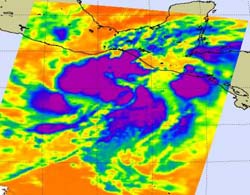NASA eyes low in eastern Pacific for tropical development

NASA\'s Aqua satellite infrared image on May 27 at 1:35 a.m. EDT showed System 90E with four areas of strong thunderstorms with very high, cold cloud tops (purple) around the center of circulation. Credit: NASA JPL, Ed Olsen<br>
AIRS, the Atmospheric Infrared Sounder instrument on Aqua, provides scientists with infrared satellite imagery. That imagery measures cloud top temperatures and sea surface temperatures. If the cloud tops in low pressure areas or tropical cyclones are colder than -63 degrees Fahrenheit, it indicates strong thunderstorms and strong convection (rapidly rising air that condenses and forms the thunderstorms that power tropical cyclones).
On May 27 at 1:35 a.m. EDT (05:35 UTC) AIRS imagery showed System 90E developing the trademark tropical cyclone approximately 205 nautical miles south of Salina Cruz, Mexico near 12.8 North and 94.5 West. AIRS infrared imagery indicated there were four areas of strong thunderstorms with very high, cold cloud tops around the center of circulation. Infrared satellite imagery indicates a slowly consolidating, broad low-level circulation center.
Winds in the area are estimated to be 20 to 25 knots (23-28 mph). System 90E is trudging west at 1 mph. The Joint Typhoon Warning Center noted that System 90E “is expected to continue consolidating over the next 24-36 hours. The potential for the development of a significant tropical cyclone within the next 24 hours is good.”
Media Contact
More Information:
http://www.nasa.govAll latest news from the category: Earth Sciences
Earth Sciences (also referred to as Geosciences), which deals with basic issues surrounding our planet, plays a vital role in the area of energy and raw materials supply.
Earth Sciences comprises subjects such as geology, geography, geological informatics, paleontology, mineralogy, petrography, crystallography, geophysics, geodesy, glaciology, cartography, photogrammetry, meteorology and seismology, early-warning systems, earthquake research and polar research.
Newest articles

Properties of new materials for microchips
… can now be measured well. Reseachers of Delft University of Technology demonstrated measuring performance properties of ultrathin silicon membranes. Making ever smaller and more powerful chips requires new ultrathin…

Floating solar’s potential
… to support sustainable development by addressing climate, water, and energy goals holistically. A new study published this week in Nature Energy raises the potential for floating solar photovoltaics (FPV)…

Skyrmions move at record speeds
… a step towards the computing of the future. An international research team led by scientists from the CNRS1 has discovered that the magnetic nanobubbles2 known as skyrmions can be…




















